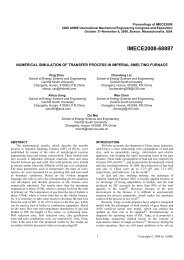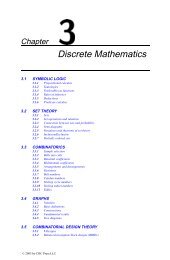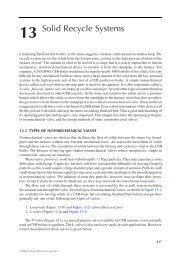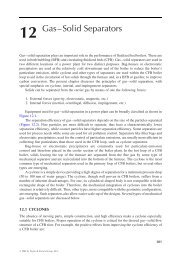Chapter 4: Geometry
Chapter 4: Geometry
Chapter 4: Geometry
Create successful ePaper yourself
Turn your PDF publications into a flip-book with our unique Google optimized e-Paper software.
Angle between lines with direction angles « ¼ ¬ ¼ ¼ and « ½ ¬ ½ ½ :<br />
Ó× ½´Ó× « ¼ Ó× « ½ · Ó× ¬ ¼ Ó× ¬ ½ ·Ó× ¼ Ó× ½ µ (4.13.10)<br />
4.13.3 CONCURRENCE, COPLANARITY, PARALLELISM<br />
Two lines, each specified by point and direction, are coplanar if, and only if, the<br />
determinant in the numerator of Equation (4.13.8) is zero. In this case they are<br />
concurrent (if the denominator is non-zero) or parallel (if the denominator is zero).<br />
Three lines with directions ´ ¼ ¼ ¼ µ, ´ ½ ½ ½ µ, and ´ ¾ ¾ ¾ µ are parallel<br />
to a common plane if and only if ¬ ¬¬¬¬¬<br />
¬<br />
¼ ¼ ¼¬¬¬¬¬<br />
½ ½ ½ ¼ (4.13.11)<br />
¾ ¾ ¾<br />
4.14 POLYHEDRA<br />
For any polyhedron topologically equivalent to a sphere—in particular, for any convex<br />
polyhedron—the Euler formula holds:<br />
Ú · ¾ (4.14.1)<br />
where Ú is the number of vertices, is the number of edges, and is the number of<br />
faces.<br />
Many common polyhedra are particular cases of cylinders (Section 4.15) or<br />
cones (Section 4.16). A cylinder with a polygonal base (the base is also called a<br />
directrix) is called a prism. A cone with a polygonal base is called a pyramid. A<br />
frustum of a cone with a polygonal base is called a truncated pyramid. Formulae<br />
(4.15.1), (4.16.1), and (4.16.2) give the volumes of a general prism, pyramid, and<br />
truncated pyramid.<br />
A prism whose base is a parallelogram is a parallelepiped. The volume of a<br />
parallelepiped with one vertex at the origin and adjacent vertices at ´Ü ½ Ý ½ Þ ½ µ,<br />
´Ü ¾ Ý ¾ Þ ¾ µ, and ´Ü ¿ Ý ¿ Þ ¿ µ is given by<br />
volume <br />
¬ Ü ½ Ý ½ Þ ½¬¬¬¬¬<br />
Ü ¾ Ý ¾ Þ ¾ (4.14.2)<br />
¬ Ü ¿ Ý ¿ Þ ¿<br />
The rectangular parallelepiped is a particular case: all of its faces are rectangles. If<br />
the side lengths are , the volume is , the total surface area is ¾´··µ,<br />
and each diagonal has length Ô ¾ · ¾ · ¾ . When we get the cube. See<br />
Section 4.14.1. A pyramid whose base is a triangle is a tetrahedron. The volume<br />
of a tetrahedon with one vertex at the origin and the other vertices at ´Ü ½ Ý ½ Þ ½ µ,<br />
© 2003 by CRC Press LLC










